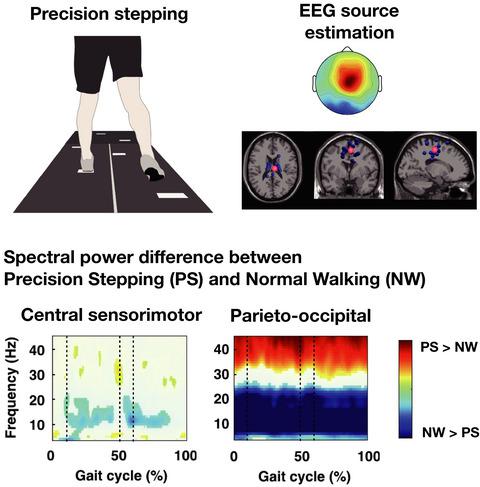当前位置:
X-MOL 学术
›
Eur. J. Neurosci.
›
论文详情
Our official English website, www.x-mol.net, welcomes your
feedback! (Note: you will need to create a separate account there.)
Gait-phase-dependent and gait-phase-independent cortical activity across multiple regions involved in voluntary gait modifications in humans
European Journal of Neuroscience ( IF 2.7 ) Pub Date : 2020-06-18 , DOI: 10.1111/ejn.14867 Hikaru Yokoyama 1, 2, 3 , Naotsugu Kaneko 3, 4 , Yohei Masugi 4, 5 , Tetsuya Ogawa 4, 6 , Katsumi Watanabe 7, 8, 9 , Kimitaka Nakazawa 4
European Journal of Neuroscience ( IF 2.7 ) Pub Date : 2020-06-18 , DOI: 10.1111/ejn.14867 Hikaru Yokoyama 1, 2, 3 , Naotsugu Kaneko 3, 4 , Yohei Masugi 4, 5 , Tetsuya Ogawa 4, 6 , Katsumi Watanabe 7, 8, 9 , Kimitaka Nakazawa 4
Affiliation

|
Modification of ongoing walking movement to fit changes in external environments requires accurate voluntary control. In cats, the motor and posterior parietal cortices have crucial roles for precisely adjusting limb trajectory during walking. In human walking, however, it remains unclear which cortical information contributes to voluntary gait modification. In this study, we investigated cortical activity changes associated with visually guided precision stepping using electroencephalography source analysis. Our results demonstrated frequency- and gait-event-dependent changes in the cortical power spectrum elicited by voluntary gait modification. The main differences between normal walking and precision stepping were as follows: (a) the alpha, beta or gamma power decrease during the swing phases in the sensorimotor, anterior cingulate and parieto-occipital cortices, and (b) a power decrease in the theta, alpha and beta bands and increase in the gamma band throughout the gait cycle in the parieto-occipital cortex. Based on the previous knowledge of brain functions, the former change was considered to be related to execution and planning of leg movement, while the latter change was considered to be related to multisensory integration and motor awareness. Therefore, our results suggest that the gait modification is achieved by higher cortical involvements associated with different sensorimotor-related functions across multiple cortical regions including the sensorimotor, anterior cingulate and parieto-occipital cortices. The results imply the critical importance of the cortical contribution to voluntary modification in human locomotion. Further, the observed cortical information related to voluntary gait modification would contribute to developing volitional control systems of brain–machine interfaces for walking rehabilitation.
中文翻译:

涉及人类自愿步态改变的多个区域的步态阶段依赖性和步态阶段独立皮层活动
修改正在进行的步行运动以适应外部环境的变化需要准确的自主控制。在猫中,运动皮层和后顶叶皮层对于在行走过程中精确调整肢体轨迹起着至关重要的作用。然而,在人类行走中,尚不清楚哪些皮层信息有助于自愿步态改变。在这项研究中,我们使用脑电图源分析研究了与视觉引导精确步进相关的皮质活动变化。我们的研究结果表明,由自愿步态改变引起的皮层功率谱中频率和步态事件相关的变化。正常行走和精确步进之间的主要区别如下:(a)在感觉运动的摆动阶段,α、β 或 γ 功率降低,前扣带回和顶枕皮质,以及 (b) 在顶枕皮质的整个步态周期中,θ、α 和 β 波段的功率降低和 γ 波段的增加。根据之前对大脑功能的认识,前者的变化被认为与腿部运动的执行和计划有关,而后者的变化被认为与多感觉整合和运动意识有关。因此,我们的研究结果表明,步态改变是通过与多个皮层区域(包括感觉运动、前扣带回和顶枕皮层)的不同感觉运动相关功能相关的更高皮层参与来实现的。结果表明皮层对人类运动的自愿改变的贡献至关重要。更远,
更新日期:2020-06-18
中文翻译:

涉及人类自愿步态改变的多个区域的步态阶段依赖性和步态阶段独立皮层活动
修改正在进行的步行运动以适应外部环境的变化需要准确的自主控制。在猫中,运动皮层和后顶叶皮层对于在行走过程中精确调整肢体轨迹起着至关重要的作用。然而,在人类行走中,尚不清楚哪些皮层信息有助于自愿步态改变。在这项研究中,我们使用脑电图源分析研究了与视觉引导精确步进相关的皮质活动变化。我们的研究结果表明,由自愿步态改变引起的皮层功率谱中频率和步态事件相关的变化。正常行走和精确步进之间的主要区别如下:(a)在感觉运动的摆动阶段,α、β 或 γ 功率降低,前扣带回和顶枕皮质,以及 (b) 在顶枕皮质的整个步态周期中,θ、α 和 β 波段的功率降低和 γ 波段的增加。根据之前对大脑功能的认识,前者的变化被认为与腿部运动的执行和计划有关,而后者的变化被认为与多感觉整合和运动意识有关。因此,我们的研究结果表明,步态改变是通过与多个皮层区域(包括感觉运动、前扣带回和顶枕皮层)的不同感觉运动相关功能相关的更高皮层参与来实现的。结果表明皮层对人类运动的自愿改变的贡献至关重要。更远,





















































 京公网安备 11010802027423号
京公网安备 11010802027423号